Strategic Management Plan for Vodafone: Business Strategy Analysis
VerifiedAdded on 2023/06/12
|14
|4486
|184
Report
AI Summary
This report provides a comprehensive analysis of Vodafone's business strategy and strategic management plan. It begins by examining the impact of the macro environment using PESTLE analysis, stakeholder analysis, and SWOT analysis. The report then assesses Vodafone's internal and external capabilities using the McKinsey 7's model and VRIO analysis. Furthermore, it applies Porter's Five Forces to evaluate the competitive landscape and discusses the application of various theories and models for strategic planning. The report concludes with a strategic management plan that includes strategic priorities and objectives, offering a detailed overview of Vodafone's approach to achieving its goals and maintaining a competitive edge in the telecommunications industry. Desklib provides access to similar solved assignments and study resources for students.

Business Strategy
Paraphrase This Document
Need a fresh take? Get an instant paraphrase of this document with our AI Paraphraser

Contents
INTRODUCTION...........................................................................................................................1
TASK 1............................................................................................................................................1
P1 Analysing the impact of Macro Environment on organisation.........................................1
TASK 2............................................................................................................................................4
Internal and external capability of organisation....................................................................4
TASK 3............................................................................................................................................6
P3 Application of Porter's Five Forces to evaluate the competitive forces............................6
TASK 4............................................................................................................................................7
P4 Application of theories, and models for strategic planning..............................................7
M4 : Strategic management plan that includes strategic priorities and objective..................9
CONCLUSION..............................................................................................................................10
References:.....................................................................................................................................11
INTRODUCTION...........................................................................................................................1
TASK 1............................................................................................................................................1
P1 Analysing the impact of Macro Environment on organisation.........................................1
TASK 2............................................................................................................................................4
Internal and external capability of organisation....................................................................4
TASK 3............................................................................................................................................6
P3 Application of Porter's Five Forces to evaluate the competitive forces............................6
TASK 4............................................................................................................................................7
P4 Application of theories, and models for strategic planning..............................................7
M4 : Strategic management plan that includes strategic priorities and objective..................9
CONCLUSION..............................................................................................................................10
References:.....................................................................................................................................11
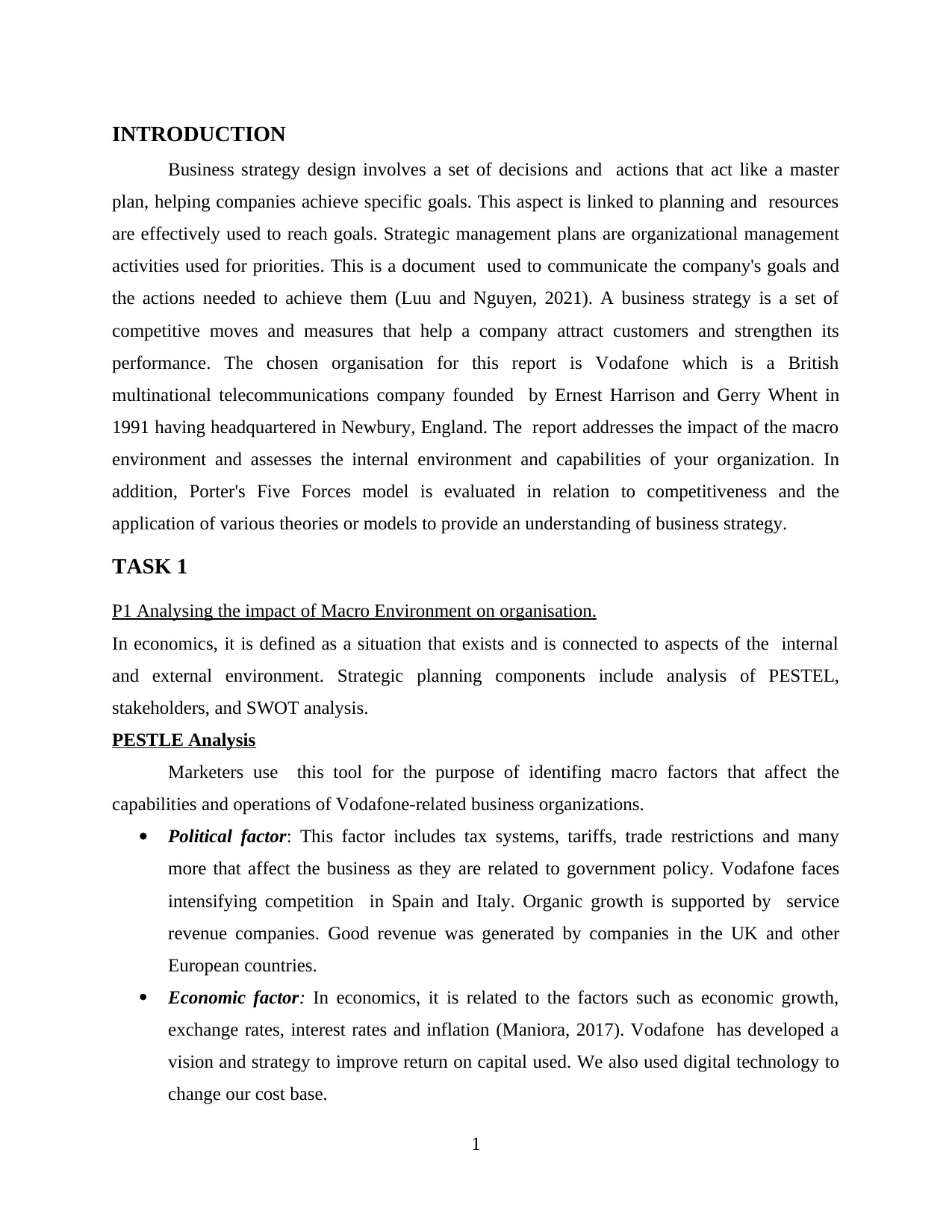
INTRODUCTION
Business strategy design involves a set of decisions and actions that act like a master
plan, helping companies achieve specific goals. This aspect is linked to planning and resources
are effectively used to reach goals. Strategic management plans are organizational management
activities used for priorities. This is a document used to communicate the company's goals and
the actions needed to achieve them (Luu and Nguyen, 2021). A business strategy is a set of
competitive moves and measures that help a company attract customers and strengthen its
performance. The chosen organisation for this report is Vodafone which is a British
multinational telecommunications company founded by Ernest Harrison and Gerry Whent in
1991 having headquartered in Newbury, England. The report addresses the impact of the macro
environment and assesses the internal environment and capabilities of your organization. In
addition, Porter's Five Forces model is evaluated in relation to competitiveness and the
application of various theories or models to provide an understanding of business strategy.
TASK 1
P1 Analysing the impact of Macro Environment on organisation.
In economics, it is defined as a situation that exists and is connected to aspects of the internal
and external environment. Strategic planning components include analysis of PESTEL,
stakeholders, and SWOT analysis.
PESTLE Analysis
Marketers use this tool for the purpose of identifing macro factors that affect the
capabilities and operations of Vodafone-related business organizations.
Political factor: This factor includes tax systems, tariffs, trade restrictions and many
more that affect the business as they are related to government policy. Vodafone faces
intensifying competition in Spain and Italy. Organic growth is supported by service
revenue companies. Good revenue was generated by companies in the UK and other
European countries.
Economic factor: In economics, it is related to the factors such as economic growth,
exchange rates, interest rates and inflation (Maniora, 2017). Vodafone has developed a
vision and strategy to improve return on capital used. We also used digital technology to
change our cost base.
1
Business strategy design involves a set of decisions and actions that act like a master
plan, helping companies achieve specific goals. This aspect is linked to planning and resources
are effectively used to reach goals. Strategic management plans are organizational management
activities used for priorities. This is a document used to communicate the company's goals and
the actions needed to achieve them (Luu and Nguyen, 2021). A business strategy is a set of
competitive moves and measures that help a company attract customers and strengthen its
performance. The chosen organisation for this report is Vodafone which is a British
multinational telecommunications company founded by Ernest Harrison and Gerry Whent in
1991 having headquartered in Newbury, England. The report addresses the impact of the macro
environment and assesses the internal environment and capabilities of your organization. In
addition, Porter's Five Forces model is evaluated in relation to competitiveness and the
application of various theories or models to provide an understanding of business strategy.
TASK 1
P1 Analysing the impact of Macro Environment on organisation.
In economics, it is defined as a situation that exists and is connected to aspects of the internal
and external environment. Strategic planning components include analysis of PESTEL,
stakeholders, and SWOT analysis.
PESTLE Analysis
Marketers use this tool for the purpose of identifing macro factors that affect the
capabilities and operations of Vodafone-related business organizations.
Political factor: This factor includes tax systems, tariffs, trade restrictions and many
more that affect the business as they are related to government policy. Vodafone faces
intensifying competition in Spain and Italy. Organic growth is supported by service
revenue companies. Good revenue was generated by companies in the UK and other
European countries.
Economic factor: In economics, it is related to the factors such as economic growth,
exchange rates, interest rates and inflation (Maniora, 2017). Vodafone has developed a
vision and strategy to improve return on capital used. We also used digital technology to
change our cost base.
1
⊘ This is a preview!⊘
Do you want full access?
Subscribe today to unlock all pages.

Trusted by 1+ million students worldwide
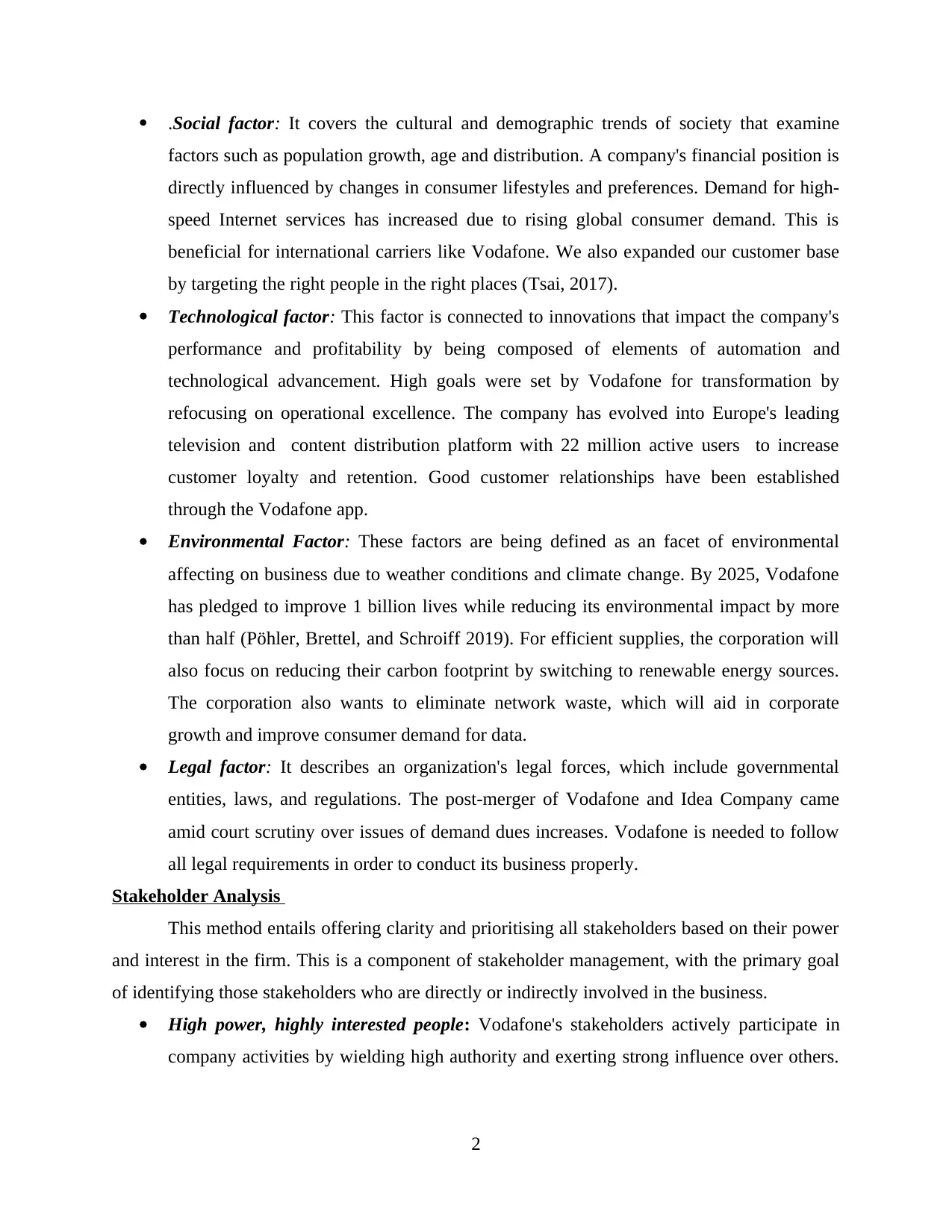
.Social factor: It covers the cultural and demographic trends of society that examine
factors such as population growth, age and distribution. A company's financial position is
directly influenced by changes in consumer lifestyles and preferences. Demand for high-
speed Internet services has increased due to rising global consumer demand. This is
beneficial for international carriers like Vodafone. We also expanded our customer base
by targeting the right people in the right places (Tsai, 2017).
Technological factor: This factor is connected to innovations that impact the company's
performance and profitability by being composed of elements of automation and
technological advancement. High goals were set by Vodafone for transformation by
refocusing on operational excellence. The company has evolved into Europe's leading
television and content distribution platform with 22 million active users to increase
customer loyalty and retention. Good customer relationships have been established
through the Vodafone app.
Environmental Factor: These factors are being defined as an facet of environmental
affecting on business due to weather conditions and climate change. By 2025, Vodafone
has pledged to improve 1 billion lives while reducing its environmental impact by more
than half (Pöhler, Brettel, and Schroiff 2019). For efficient supplies, the corporation will
also focus on reducing their carbon footprint by switching to renewable energy sources.
The corporation also wants to eliminate network waste, which will aid in corporate
growth and improve consumer demand for data.
Legal factor: It describes an organization's legal forces, which include governmental
entities, laws, and regulations. The post-merger of Vodafone and Idea Company came
amid court scrutiny over issues of demand dues increases. Vodafone is needed to follow
all legal requirements in order to conduct its business properly.
Stakeholder Analysis
This method entails offering clarity and prioritising all stakeholders based on their power
and interest in the firm. This is a component of stakeholder management, with the primary goal
of identifying those stakeholders who are directly or indirectly involved in the business.
High power, highly interested people: Vodafone's stakeholders actively participate in
company activities by wielding high authority and exerting strong influence over others.
2
factors such as population growth, age and distribution. A company's financial position is
directly influenced by changes in consumer lifestyles and preferences. Demand for high-
speed Internet services has increased due to rising global consumer demand. This is
beneficial for international carriers like Vodafone. We also expanded our customer base
by targeting the right people in the right places (Tsai, 2017).
Technological factor: This factor is connected to innovations that impact the company's
performance and profitability by being composed of elements of automation and
technological advancement. High goals were set by Vodafone for transformation by
refocusing on operational excellence. The company has evolved into Europe's leading
television and content distribution platform with 22 million active users to increase
customer loyalty and retention. Good customer relationships have been established
through the Vodafone app.
Environmental Factor: These factors are being defined as an facet of environmental
affecting on business due to weather conditions and climate change. By 2025, Vodafone
has pledged to improve 1 billion lives while reducing its environmental impact by more
than half (Pöhler, Brettel, and Schroiff 2019). For efficient supplies, the corporation will
also focus on reducing their carbon footprint by switching to renewable energy sources.
The corporation also wants to eliminate network waste, which will aid in corporate
growth and improve consumer demand for data.
Legal factor: It describes an organization's legal forces, which include governmental
entities, laws, and regulations. The post-merger of Vodafone and Idea Company came
amid court scrutiny over issues of demand dues increases. Vodafone is needed to follow
all legal requirements in order to conduct its business properly.
Stakeholder Analysis
This method entails offering clarity and prioritising all stakeholders based on their power
and interest in the firm. This is a component of stakeholder management, with the primary goal
of identifying those stakeholders who are directly or indirectly involved in the business.
High power, highly interested people: Vodafone's stakeholders actively participate in
company activities by wielding high authority and exerting strong influence over others.
2
Paraphrase This Document
Need a fresh take? Get an instant paraphrase of this document with our AI Paraphraser
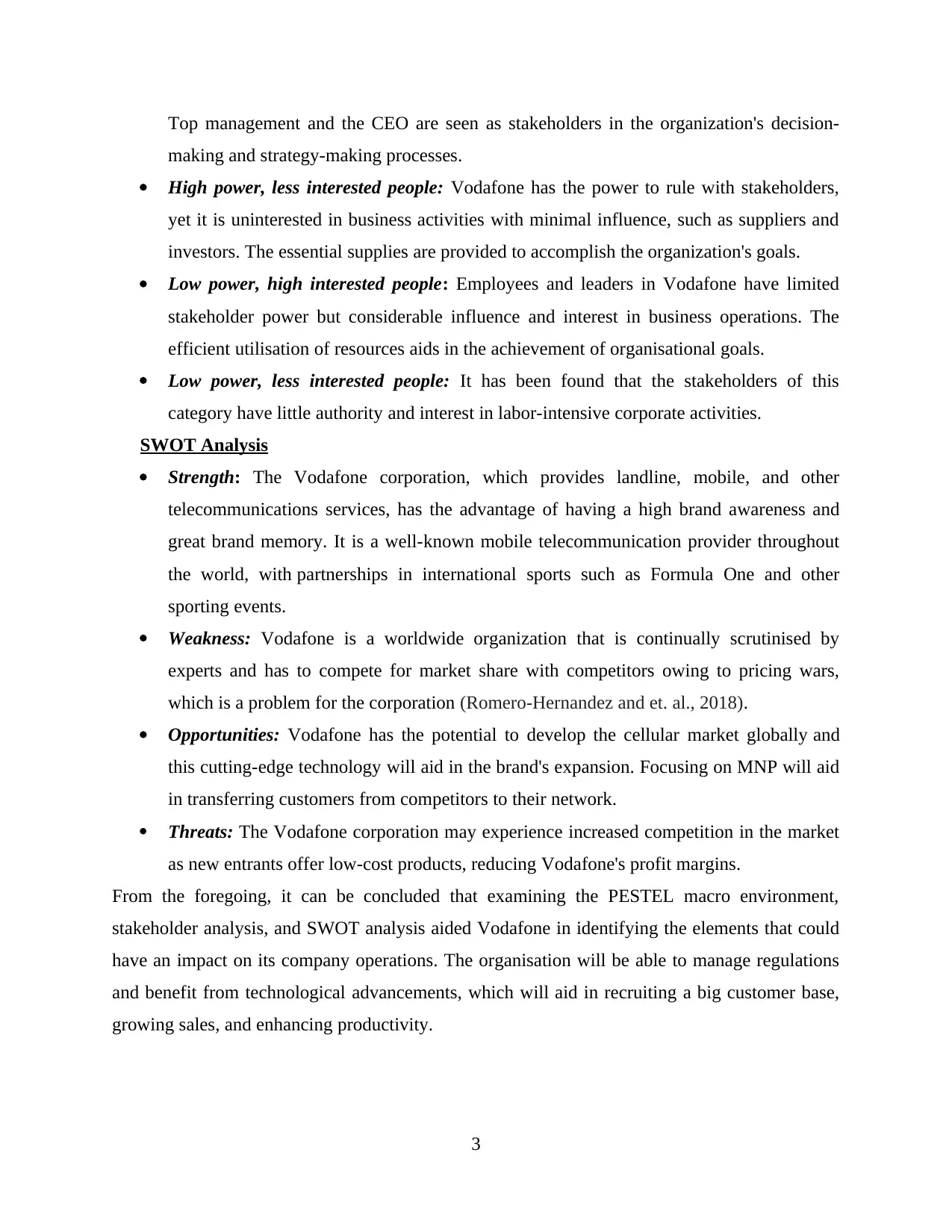
Top management and the CEO are seen as stakeholders in the organization's decision-
making and strategy-making processes.
High power, less interested people: Vodafone has the power to rule with stakeholders,
yet it is uninterested in business activities with minimal influence, such as suppliers and
investors. The essential supplies are provided to accomplish the organization's goals.
Low power, high interested people: Employees and leaders in Vodafone have limited
stakeholder power but considerable influence and interest in business operations. The
efficient utilisation of resources aids in the achievement of organisational goals.
Low power, less interested people: It has been found that the stakeholders of this
category have little authority and interest in labor-intensive corporate activities.
SWOT Analysis
Strength: The Vodafone corporation, which provides landline, mobile, and other
telecommunications services, has the advantage of having a high brand awareness and
great brand memory. It is a well-known mobile telecommunication provider throughout
the world, with partnerships in international sports such as Formula One and other
sporting events.
Weakness: Vodafone is a worldwide organization that is continually scrutinised by
experts and has to compete for market share with competitors owing to pricing wars,
which is a problem for the corporation (Romero-Hernandez and et. al., 2018).
Opportunities: Vodafone has the potential to develop the cellular market globally and
this cutting-edge technology will aid in the brand's expansion. Focusing on MNP will aid
in transferring customers from competitors to their network.
Threats: The Vodafone corporation may experience increased competition in the market
as new entrants offer low-cost products, reducing Vodafone's profit margins.
From the foregoing, it can be concluded that examining the PESTEL macro environment,
stakeholder analysis, and SWOT analysis aided Vodafone in identifying the elements that could
have an impact on its company operations. The organisation will be able to manage regulations
and benefit from technological advancements, which will aid in recruiting a big customer base,
growing sales, and enhancing productivity.
3
making and strategy-making processes.
High power, less interested people: Vodafone has the power to rule with stakeholders,
yet it is uninterested in business activities with minimal influence, such as suppliers and
investors. The essential supplies are provided to accomplish the organization's goals.
Low power, high interested people: Employees and leaders in Vodafone have limited
stakeholder power but considerable influence and interest in business operations. The
efficient utilisation of resources aids in the achievement of organisational goals.
Low power, less interested people: It has been found that the stakeholders of this
category have little authority and interest in labor-intensive corporate activities.
SWOT Analysis
Strength: The Vodafone corporation, which provides landline, mobile, and other
telecommunications services, has the advantage of having a high brand awareness and
great brand memory. It is a well-known mobile telecommunication provider throughout
the world, with partnerships in international sports such as Formula One and other
sporting events.
Weakness: Vodafone is a worldwide organization that is continually scrutinised by
experts and has to compete for market share with competitors owing to pricing wars,
which is a problem for the corporation (Romero-Hernandez and et. al., 2018).
Opportunities: Vodafone has the potential to develop the cellular market globally and
this cutting-edge technology will aid in the brand's expansion. Focusing on MNP will aid
in transferring customers from competitors to their network.
Threats: The Vodafone corporation may experience increased competition in the market
as new entrants offer low-cost products, reducing Vodafone's profit margins.
From the foregoing, it can be concluded that examining the PESTEL macro environment,
stakeholder analysis, and SWOT analysis aided Vodafone in identifying the elements that could
have an impact on its company operations. The organisation will be able to manage regulations
and benefit from technological advancements, which will aid in recruiting a big customer base,
growing sales, and enhancing productivity.
3
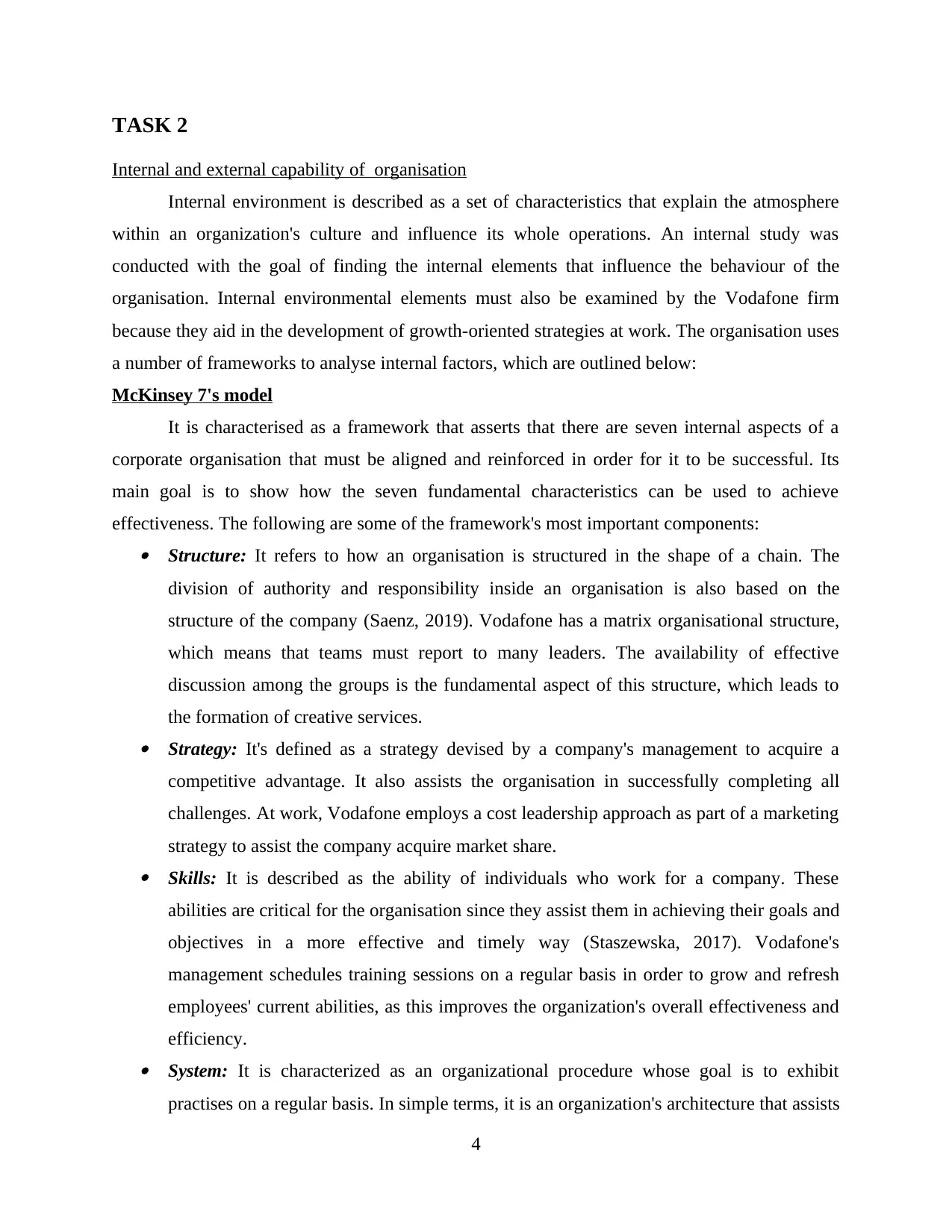
TASK 2
Internal and external capability of organisation
Internal environment is described as a set of characteristics that explain the atmosphere
within an organization's culture and influence its whole operations. An internal study was
conducted with the goal of finding the internal elements that influence the behaviour of the
organisation. Internal environmental elements must also be examined by the Vodafone firm
because they aid in the development of growth-oriented strategies at work. The organisation uses
a number of frameworks to analyse internal factors, which are outlined below:
McKinsey 7's model
It is characterised as a framework that asserts that there are seven internal aspects of a
corporate organisation that must be aligned and reinforced in order for it to be successful. Its
main goal is to show how the seven fundamental characteristics can be used to achieve
effectiveness. The following are some of the framework's most important components: Structure: It refers to how an organisation is structured in the shape of a chain. The
division of authority and responsibility inside an organisation is also based on the
structure of the company (Saenz, 2019). Vodafone has a matrix organisational structure,
which means that teams must report to many leaders. The availability of effective
discussion among the groups is the fundamental aspect of this structure, which leads to
the formation of creative services. Strategy: It's defined as a strategy devised by a company's management to acquire a
competitive advantage. It also assists the organisation in successfully completing all
challenges. At work, Vodafone employs a cost leadership approach as part of a marketing
strategy to assist the company acquire market share. Skills: It is described as the ability of individuals who work for a company. These
abilities are critical for the organisation since they assist them in achieving their goals and
objectives in a more effective and timely way (Staszewska, 2017). Vodafone's
management schedules training sessions on a regular basis in order to grow and refresh
employees' current abilities, as this improves the organization's overall effectiveness and
efficiency. System: It is characterized as an organizational procedure whose goal is to exhibit
practises on a regular basis. In simple terms, it is an organization's architecture that assists
4
Internal and external capability of organisation
Internal environment is described as a set of characteristics that explain the atmosphere
within an organization's culture and influence its whole operations. An internal study was
conducted with the goal of finding the internal elements that influence the behaviour of the
organisation. Internal environmental elements must also be examined by the Vodafone firm
because they aid in the development of growth-oriented strategies at work. The organisation uses
a number of frameworks to analyse internal factors, which are outlined below:
McKinsey 7's model
It is characterised as a framework that asserts that there are seven internal aspects of a
corporate organisation that must be aligned and reinforced in order for it to be successful. Its
main goal is to show how the seven fundamental characteristics can be used to achieve
effectiveness. The following are some of the framework's most important components: Structure: It refers to how an organisation is structured in the shape of a chain. The
division of authority and responsibility inside an organisation is also based on the
structure of the company (Saenz, 2019). Vodafone has a matrix organisational structure,
which means that teams must report to many leaders. The availability of effective
discussion among the groups is the fundamental aspect of this structure, which leads to
the formation of creative services. Strategy: It's defined as a strategy devised by a company's management to acquire a
competitive advantage. It also assists the organisation in successfully completing all
challenges. At work, Vodafone employs a cost leadership approach as part of a marketing
strategy to assist the company acquire market share. Skills: It is described as the ability of individuals who work for a company. These
abilities are critical for the organisation since they assist them in achieving their goals and
objectives in a more effective and timely way (Staszewska, 2017). Vodafone's
management schedules training sessions on a regular basis in order to grow and refresh
employees' current abilities, as this improves the organization's overall effectiveness and
efficiency. System: It is characterized as an organizational procedure whose goal is to exhibit
practises on a regular basis. In simple terms, it is an organization's architecture that assists
4
⊘ This is a preview!⊘
Do you want full access?
Subscribe today to unlock all pages.

Trusted by 1+ million students worldwide
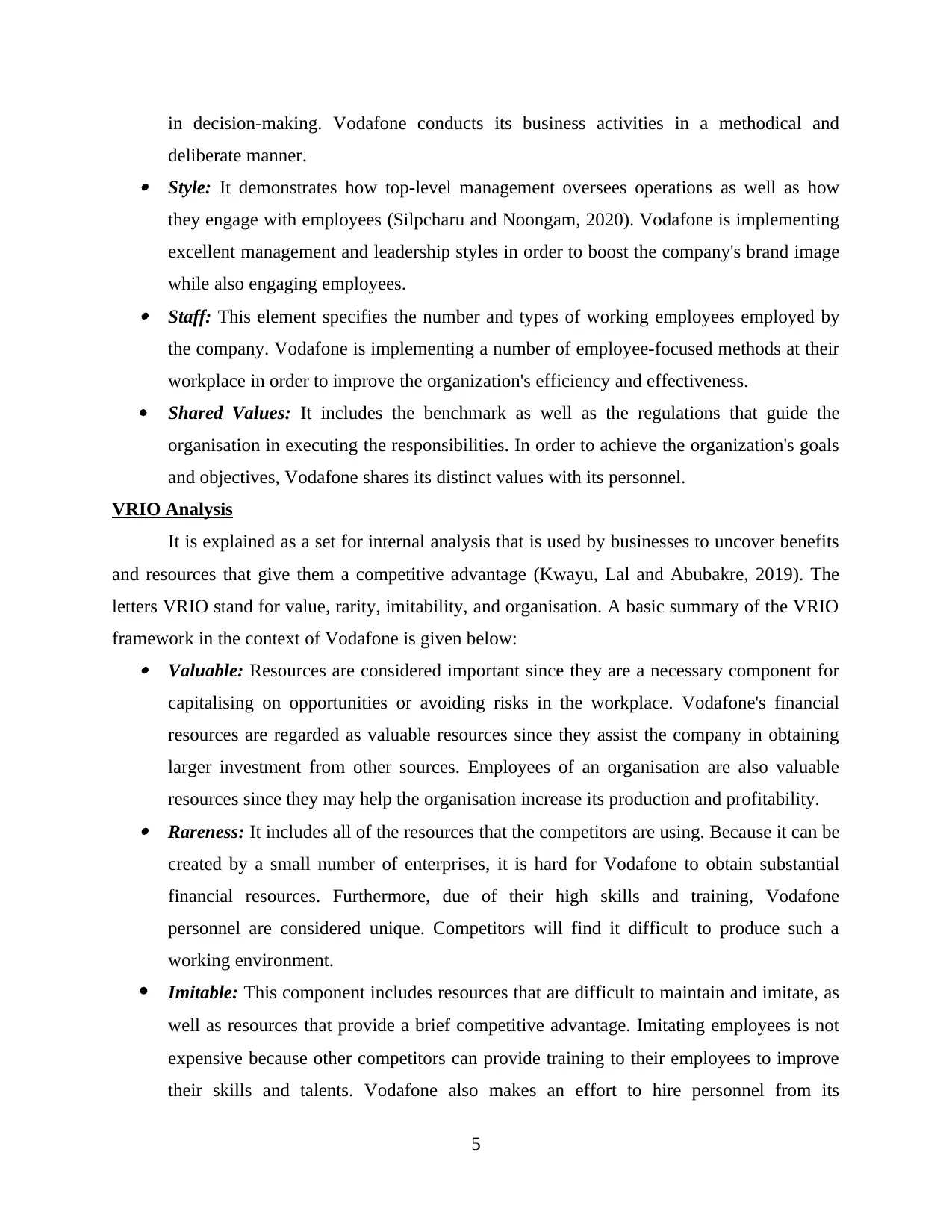
in decision-making. Vodafone conducts its business activities in a methodical and
deliberate manner. Style: It demonstrates how top-level management oversees operations as well as how
they engage with employees (Silpcharu and Noongam, 2020). Vodafone is implementing
excellent management and leadership styles in order to boost the company's brand image
while also engaging employees. Staff: This element specifies the number and types of working employees employed by
the company. Vodafone is implementing a number of employee-focused methods at their
workplace in order to improve the organization's efficiency and effectiveness.
Shared Values: It includes the benchmark as well as the regulations that guide the
organisation in executing the responsibilities. In order to achieve the organization's goals
and objectives, Vodafone shares its distinct values with its personnel.
VRIO Analysis
It is explained as a set for internal analysis that is used by businesses to uncover benefits
and resources that give them a competitive advantage (Kwayu, Lal and Abubakre, 2019). The
letters VRIO stand for value, rarity, imitability, and organisation. A basic summary of the VRIO
framework in the context of Vodafone is given below: Valuable: Resources are considered important since they are a necessary component for
capitalising on opportunities or avoiding risks in the workplace. Vodafone's financial
resources are regarded as valuable resources since they assist the company in obtaining
larger investment from other sources. Employees of an organisation are also valuable
resources since they may help the organisation increase its production and profitability. Rareness: It includes all of the resources that the competitors are using. Because it can be
created by a small number of enterprises, it is hard for Vodafone to obtain substantial
financial resources. Furthermore, due of their high skills and training, Vodafone
personnel are considered unique. Competitors will find it difficult to produce such a
working environment.
Imitable: This component includes resources that are difficult to maintain and imitate, as
well as resources that provide a brief competitive advantage. Imitating employees is not
expensive because other competitors can provide training to their employees to improve
their skills and talents. Vodafone also makes an effort to hire personnel from its
5
deliberate manner. Style: It demonstrates how top-level management oversees operations as well as how
they engage with employees (Silpcharu and Noongam, 2020). Vodafone is implementing
excellent management and leadership styles in order to boost the company's brand image
while also engaging employees. Staff: This element specifies the number and types of working employees employed by
the company. Vodafone is implementing a number of employee-focused methods at their
workplace in order to improve the organization's efficiency and effectiveness.
Shared Values: It includes the benchmark as well as the regulations that guide the
organisation in executing the responsibilities. In order to achieve the organization's goals
and objectives, Vodafone shares its distinct values with its personnel.
VRIO Analysis
It is explained as a set for internal analysis that is used by businesses to uncover benefits
and resources that give them a competitive advantage (Kwayu, Lal and Abubakre, 2019). The
letters VRIO stand for value, rarity, imitability, and organisation. A basic summary of the VRIO
framework in the context of Vodafone is given below: Valuable: Resources are considered important since they are a necessary component for
capitalising on opportunities or avoiding risks in the workplace. Vodafone's financial
resources are regarded as valuable resources since they assist the company in obtaining
larger investment from other sources. Employees of an organisation are also valuable
resources since they may help the organisation increase its production and profitability. Rareness: It includes all of the resources that the competitors are using. Because it can be
created by a small number of enterprises, it is hard for Vodafone to obtain substantial
financial resources. Furthermore, due of their high skills and training, Vodafone
personnel are considered unique. Competitors will find it difficult to produce such a
working environment.
Imitable: This component includes resources that are difficult to maintain and imitate, as
well as resources that provide a brief competitive advantage. Imitating employees is not
expensive because other competitors can provide training to their employees to improve
their skills and talents. Vodafone also makes an effort to hire personnel from its
5
Paraphrase This Document
Need a fresh take? Get an instant paraphrase of this document with our AI Paraphraser
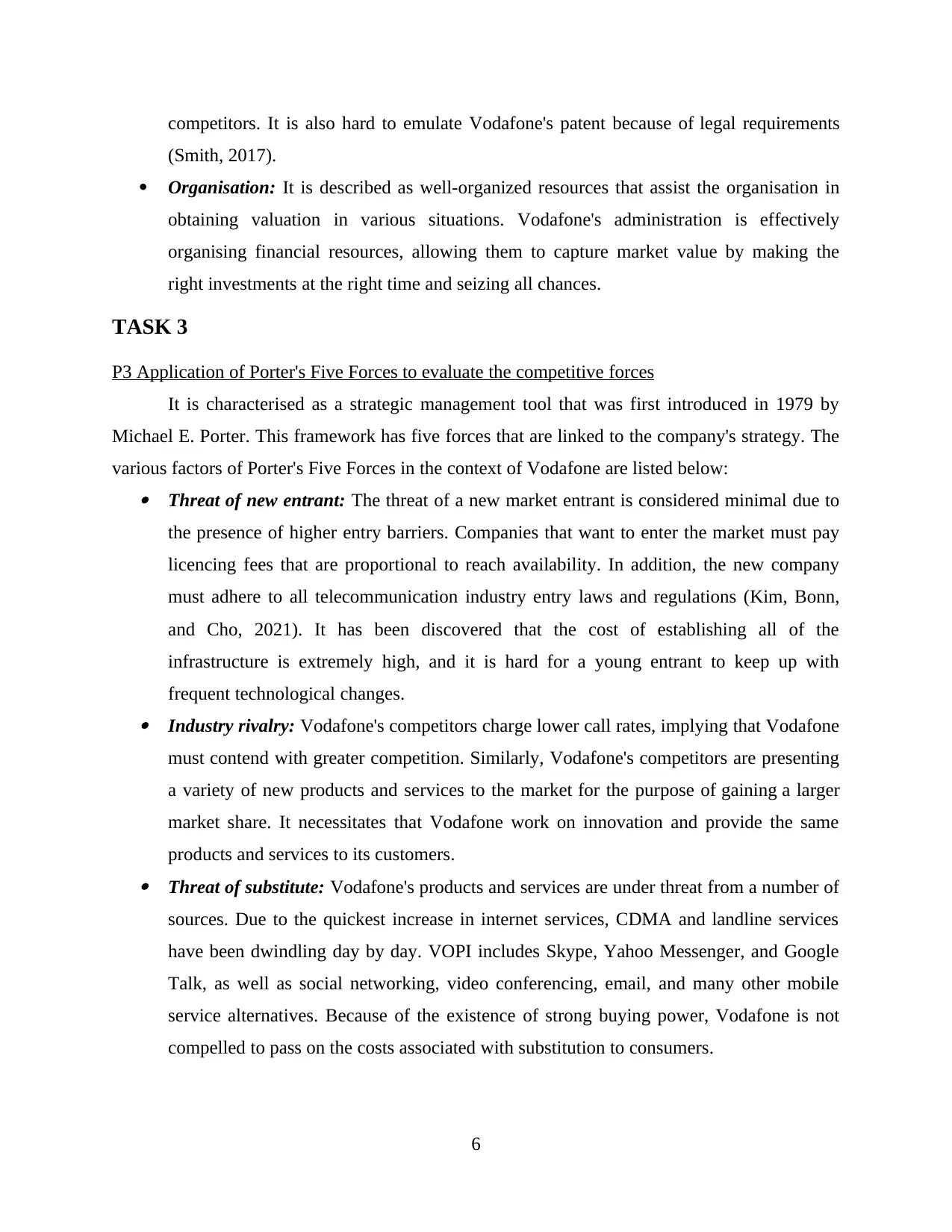
competitors. It is also hard to emulate Vodafone's patent because of legal requirements
(Smith, 2017).
Organisation: It is described as well-organized resources that assist the organisation in
obtaining valuation in various situations. Vodafone's administration is effectively
organising financial resources, allowing them to capture market value by making the
right investments at the right time and seizing all chances.
TASK 3
P3 Application of Porter's Five Forces to evaluate the competitive forces
It is characterised as a strategic management tool that was first introduced in 1979 by
Michael E. Porter. This framework has five forces that are linked to the company's strategy. The
various factors of Porter's Five Forces in the context of Vodafone are listed below: Threat of new entrant: The threat of a new market entrant is considered minimal due to
the presence of higher entry barriers. Companies that want to enter the market must pay
licencing fees that are proportional to reach availability. In addition, the new company
must adhere to all telecommunication industry entry laws and regulations (Kim, Bonn,
and Cho, 2021). It has been discovered that the cost of establishing all of the
infrastructure is extremely high, and it is hard for a young entrant to keep up with
frequent technological changes. Industry rivalry: Vodafone's competitors charge lower call rates, implying that Vodafone
must contend with greater competition. Similarly, Vodafone's competitors are presenting
a variety of new products and services to the market for the purpose of gaining a larger
market share. It necessitates that Vodafone work on innovation and provide the same
products and services to its customers. Threat of substitute: Vodafone's products and services are under threat from a number of
sources. Due to the quickest increase in internet services, CDMA and landline services
have been dwindling day by day. VOPI includes Skype, Yahoo Messenger, and Google
Talk, as well as social networking, video conferencing, email, and many other mobile
service alternatives. Because of the existence of strong buying power, Vodafone is not
compelled to pass on the costs associated with substitution to consumers.
6
(Smith, 2017).
Organisation: It is described as well-organized resources that assist the organisation in
obtaining valuation in various situations. Vodafone's administration is effectively
organising financial resources, allowing them to capture market value by making the
right investments at the right time and seizing all chances.
TASK 3
P3 Application of Porter's Five Forces to evaluate the competitive forces
It is characterised as a strategic management tool that was first introduced in 1979 by
Michael E. Porter. This framework has five forces that are linked to the company's strategy. The
various factors of Porter's Five Forces in the context of Vodafone are listed below: Threat of new entrant: The threat of a new market entrant is considered minimal due to
the presence of higher entry barriers. Companies that want to enter the market must pay
licencing fees that are proportional to reach availability. In addition, the new company
must adhere to all telecommunication industry entry laws and regulations (Kim, Bonn,
and Cho, 2021). It has been discovered that the cost of establishing all of the
infrastructure is extremely high, and it is hard for a young entrant to keep up with
frequent technological changes. Industry rivalry: Vodafone's competitors charge lower call rates, implying that Vodafone
must contend with greater competition. Similarly, Vodafone's competitors are presenting
a variety of new products and services to the market for the purpose of gaining a larger
market share. It necessitates that Vodafone work on innovation and provide the same
products and services to its customers. Threat of substitute: Vodafone's products and services are under threat from a number of
sources. Due to the quickest increase in internet services, CDMA and landline services
have been dwindling day by day. VOPI includes Skype, Yahoo Messenger, and Google
Talk, as well as social networking, video conferencing, email, and many other mobile
service alternatives. Because of the existence of strong buying power, Vodafone is not
compelled to pass on the costs associated with substitution to consumers.
6
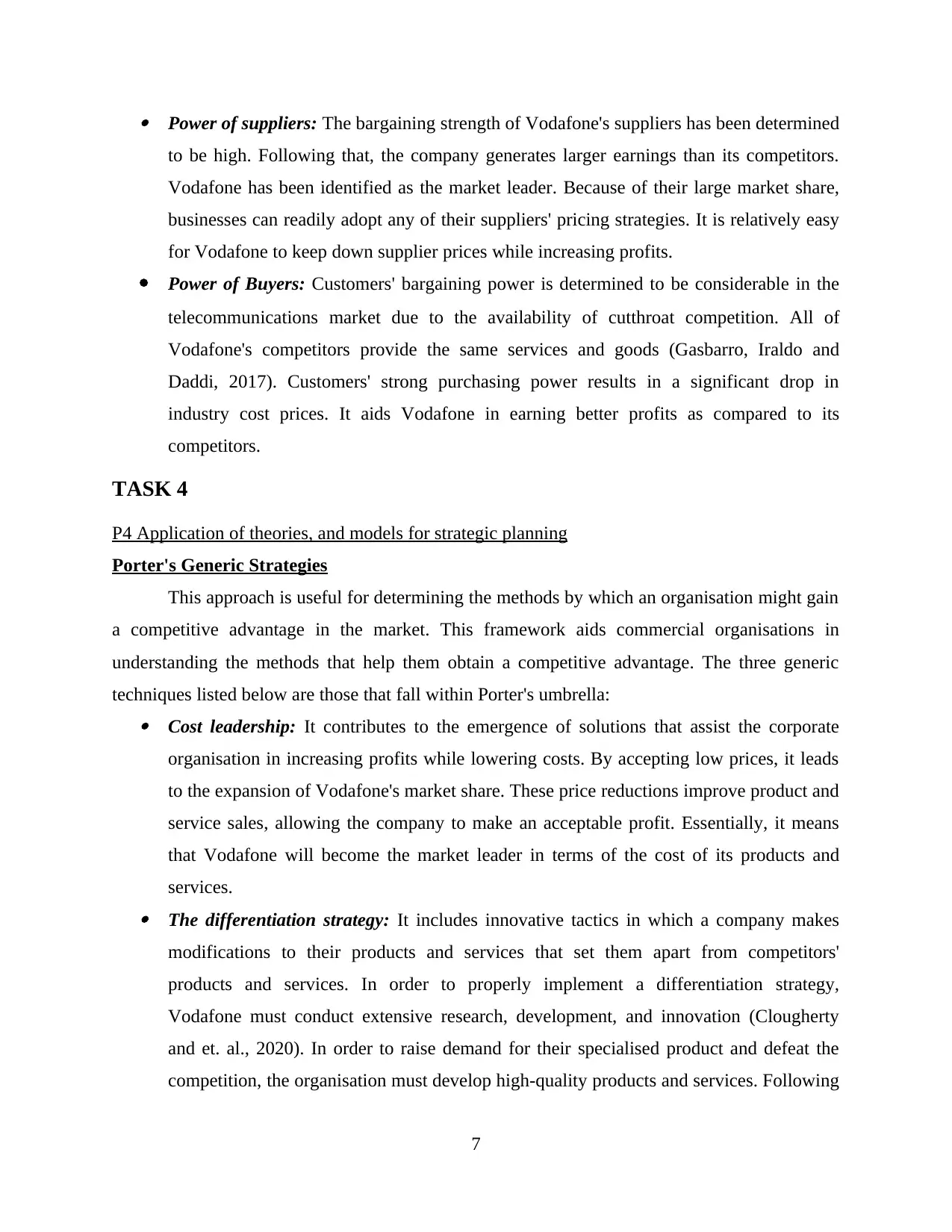
Power of suppliers: The bargaining strength of Vodafone's suppliers has been determined
to be high. Following that, the company generates larger earnings than its competitors.
Vodafone has been identified as the market leader. Because of their large market share,
businesses can readily adopt any of their suppliers' pricing strategies. It is relatively easy
for Vodafone to keep down supplier prices while increasing profits.
Power of Buyers: Customers' bargaining power is determined to be considerable in the
telecommunications market due to the availability of cutthroat competition. All of
Vodafone's competitors provide the same services and goods (Gasbarro, Iraldo and
Daddi, 2017). Customers' strong purchasing power results in a significant drop in
industry cost prices. It aids Vodafone in earning better profits as compared to its
competitors.
TASK 4
P4 Application of theories, and models for strategic planning
Porter's Generic Strategies
This approach is useful for determining the methods by which an organisation might gain
a competitive advantage in the market. This framework aids commercial organisations in
understanding the methods that help them obtain a competitive advantage. The three generic
techniques listed below are those that fall within Porter's umbrella: Cost leadership: It contributes to the emergence of solutions that assist the corporate
organisation in increasing profits while lowering costs. By accepting low prices, it leads
to the expansion of Vodafone's market share. These price reductions improve product and
service sales, allowing the company to make an acceptable profit. Essentially, it means
that Vodafone will become the market leader in terms of the cost of its products and
services. The differentiation strategy: It includes innovative tactics in which a company makes
modifications to their products and services that set them apart from competitors'
products and services. In order to properly implement a differentiation strategy,
Vodafone must conduct extensive research, development, and innovation (Clougherty
and et. al., 2020). In order to raise demand for their specialised product and defeat the
competition, the organisation must develop high-quality products and services. Following
7
to be high. Following that, the company generates larger earnings than its competitors.
Vodafone has been identified as the market leader. Because of their large market share,
businesses can readily adopt any of their suppliers' pricing strategies. It is relatively easy
for Vodafone to keep down supplier prices while increasing profits.
Power of Buyers: Customers' bargaining power is determined to be considerable in the
telecommunications market due to the availability of cutthroat competition. All of
Vodafone's competitors provide the same services and goods (Gasbarro, Iraldo and
Daddi, 2017). Customers' strong purchasing power results in a significant drop in
industry cost prices. It aids Vodafone in earning better profits as compared to its
competitors.
TASK 4
P4 Application of theories, and models for strategic planning
Porter's Generic Strategies
This approach is useful for determining the methods by which an organisation might gain
a competitive advantage in the market. This framework aids commercial organisations in
understanding the methods that help them obtain a competitive advantage. The three generic
techniques listed below are those that fall within Porter's umbrella: Cost leadership: It contributes to the emergence of solutions that assist the corporate
organisation in increasing profits while lowering costs. By accepting low prices, it leads
to the expansion of Vodafone's market share. These price reductions improve product and
service sales, allowing the company to make an acceptable profit. Essentially, it means
that Vodafone will become the market leader in terms of the cost of its products and
services. The differentiation strategy: It includes innovative tactics in which a company makes
modifications to their products and services that set them apart from competitors'
products and services. In order to properly implement a differentiation strategy,
Vodafone must conduct extensive research, development, and innovation (Clougherty
and et. al., 2020). In order to raise demand for their specialised product and defeat the
competition, the organisation must develop high-quality products and services. Following
7
⊘ This is a preview!⊘
Do you want full access?
Subscribe today to unlock all pages.

Trusted by 1+ million students worldwide
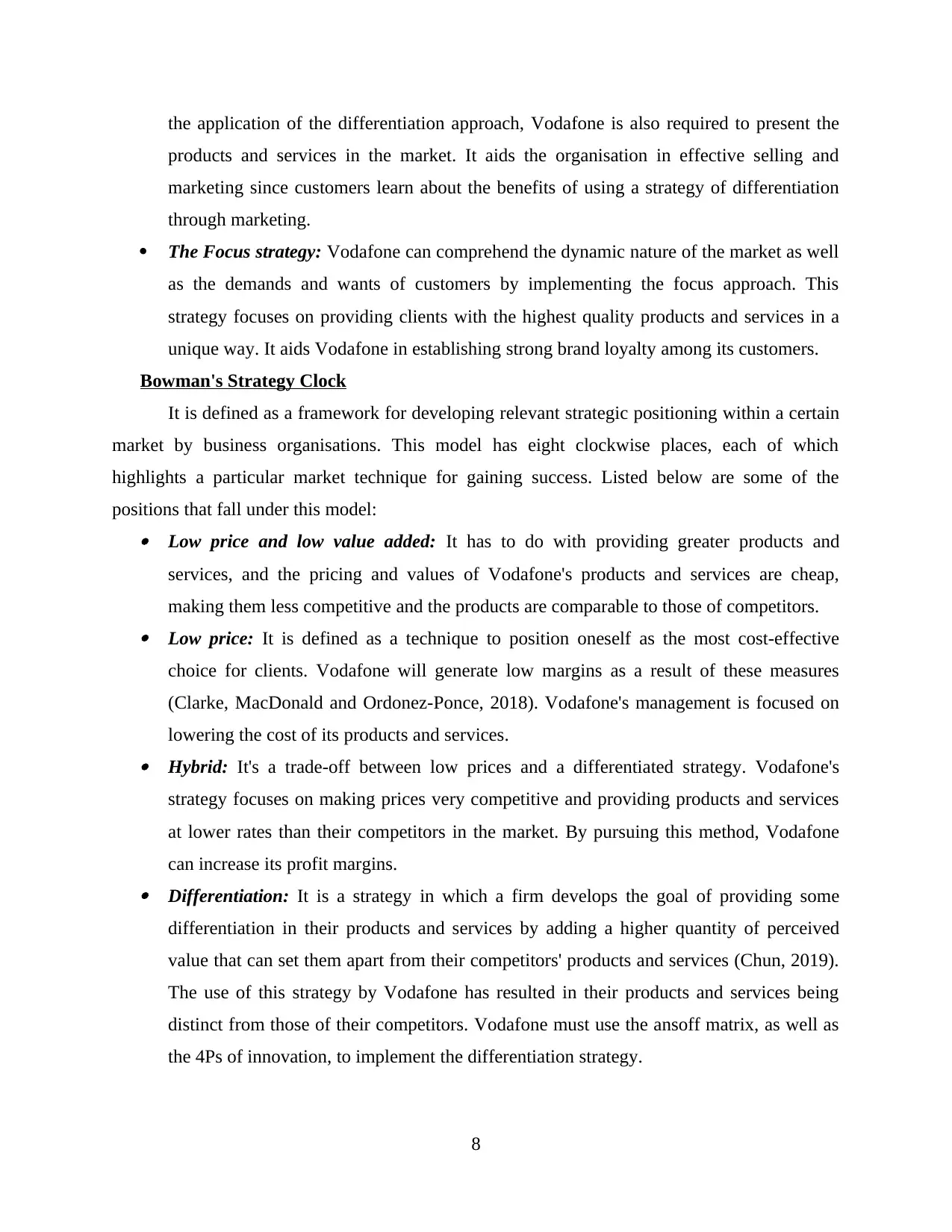
the application of the differentiation approach, Vodafone is also required to present the
products and services in the market. It aids the organisation in effective selling and
marketing since customers learn about the benefits of using a strategy of differentiation
through marketing.
The Focus strategy: Vodafone can comprehend the dynamic nature of the market as well
as the demands and wants of customers by implementing the focus approach. This
strategy focuses on providing clients with the highest quality products and services in a
unique way. It aids Vodafone in establishing strong brand loyalty among its customers.
Bowman's Strategy Clock
It is defined as a framework for developing relevant strategic positioning within a certain
market by business organisations. This model has eight clockwise places, each of which
highlights a particular market technique for gaining success. Listed below are some of the
positions that fall under this model: Low price and low value added: It has to do with providing greater products and
services, and the pricing and values of Vodafone's products and services are cheap,
making them less competitive and the products are comparable to those of competitors. Low price: It is defined as a technique to position oneself as the most cost-effective
choice for clients. Vodafone will generate low margins as a result of these measures
(Clarke, MacDonald and Ordonez-Ponce, 2018). Vodafone's management is focused on
lowering the cost of its products and services. Hybrid: It's a trade-off between low prices and a differentiated strategy. Vodafone's
strategy focuses on making prices very competitive and providing products and services
at lower rates than their competitors in the market. By pursuing this method, Vodafone
can increase its profit margins. Differentiation: It is a strategy in which a firm develops the goal of providing some
differentiation in their products and services by adding a higher quantity of perceived
value that can set them apart from their competitors' products and services (Chun, 2019).
The use of this strategy by Vodafone has resulted in their products and services being
distinct from those of their competitors. Vodafone must use the ansoff matrix, as well as
the 4Ps of innovation, to implement the differentiation strategy.
8
products and services in the market. It aids the organisation in effective selling and
marketing since customers learn about the benefits of using a strategy of differentiation
through marketing.
The Focus strategy: Vodafone can comprehend the dynamic nature of the market as well
as the demands and wants of customers by implementing the focus approach. This
strategy focuses on providing clients with the highest quality products and services in a
unique way. It aids Vodafone in establishing strong brand loyalty among its customers.
Bowman's Strategy Clock
It is defined as a framework for developing relevant strategic positioning within a certain
market by business organisations. This model has eight clockwise places, each of which
highlights a particular market technique for gaining success. Listed below are some of the
positions that fall under this model: Low price and low value added: It has to do with providing greater products and
services, and the pricing and values of Vodafone's products and services are cheap,
making them less competitive and the products are comparable to those of competitors. Low price: It is defined as a technique to position oneself as the most cost-effective
choice for clients. Vodafone will generate low margins as a result of these measures
(Clarke, MacDonald and Ordonez-Ponce, 2018). Vodafone's management is focused on
lowering the cost of its products and services. Hybrid: It's a trade-off between low prices and a differentiated strategy. Vodafone's
strategy focuses on making prices very competitive and providing products and services
at lower rates than their competitors in the market. By pursuing this method, Vodafone
can increase its profit margins. Differentiation: It is a strategy in which a firm develops the goal of providing some
differentiation in their products and services by adding a higher quantity of perceived
value that can set them apart from their competitors' products and services (Chun, 2019).
The use of this strategy by Vodafone has resulted in their products and services being
distinct from those of their competitors. Vodafone must use the ansoff matrix, as well as
the 4Ps of innovation, to implement the differentiation strategy.
8
Paraphrase This Document
Need a fresh take? Get an instant paraphrase of this document with our AI Paraphraser

Focused differentiation: This method is also known as the "high value at high pricing"
strategy. The implementation of this strategy in Vodafone results in increased earnings,
but it will be tough for the company to preserve those gains. Risky high margins: When this strategy is used at work, the company organisation
focuses on charging a high price without adding any new value to the products and
services. When Vodafone uses this technique, customers of products and services pay
more only for the organization's brand image, as no more value is offered to the items or
services to justify the higher price.
Monopoly pricing: In a monopoly market, it is characterised as a method for controlling
product and service prices. The term "monopoly market" refers to a market in which a
single organisation controls the prices of goods and services (Akgül and Tunca, 2019).
Vodafone operates in a competitive business climate, and management is essential to stay
informed about external issues that may affect product and service prices.
Loss of market shares: It is determined to be the worst position to be in, and it is advised
to businesses to operate in a declining market. This strategy might be used by Vodafone
in order to enter a new market.
M4 : Strategic management plan that includes strategic priorities and objective
Strategic management plan :
Summary Vodafone is a telecommunications sector international brand. This
organization's products and services are available in almost every
corner of the globe.
Vision Vodafone's vision statement states that the company aspires to be the
world's leading provider of communication services.
Mission Vodafone's mission is to enrich customers' lives through the unique
power of communication.
Objectives To raise sales by 15% by introducing new products.
To cover all clients in order to build a large and loyal customer
base.
Tactics Product: All telecommunication-related items and services are
9
strategy. The implementation of this strategy in Vodafone results in increased earnings,
but it will be tough for the company to preserve those gains. Risky high margins: When this strategy is used at work, the company organisation
focuses on charging a high price without adding any new value to the products and
services. When Vodafone uses this technique, customers of products and services pay
more only for the organization's brand image, as no more value is offered to the items or
services to justify the higher price.
Monopoly pricing: In a monopoly market, it is characterised as a method for controlling
product and service prices. The term "monopoly market" refers to a market in which a
single organisation controls the prices of goods and services (Akgül and Tunca, 2019).
Vodafone operates in a competitive business climate, and management is essential to stay
informed about external issues that may affect product and service prices.
Loss of market shares: It is determined to be the worst position to be in, and it is advised
to businesses to operate in a declining market. This strategy might be used by Vodafone
in order to enter a new market.
M4 : Strategic management plan that includes strategic priorities and objective
Strategic management plan :
Summary Vodafone is a telecommunications sector international brand. This
organization's products and services are available in almost every
corner of the globe.
Vision Vodafone's vision statement states that the company aspires to be the
world's leading provider of communication services.
Mission Vodafone's mission is to enrich customers' lives through the unique
power of communication.
Objectives To raise sales by 15% by introducing new products.
To cover all clients in order to build a large and loyal customer
base.
Tactics Product: All telecommunication-related items and services are
9
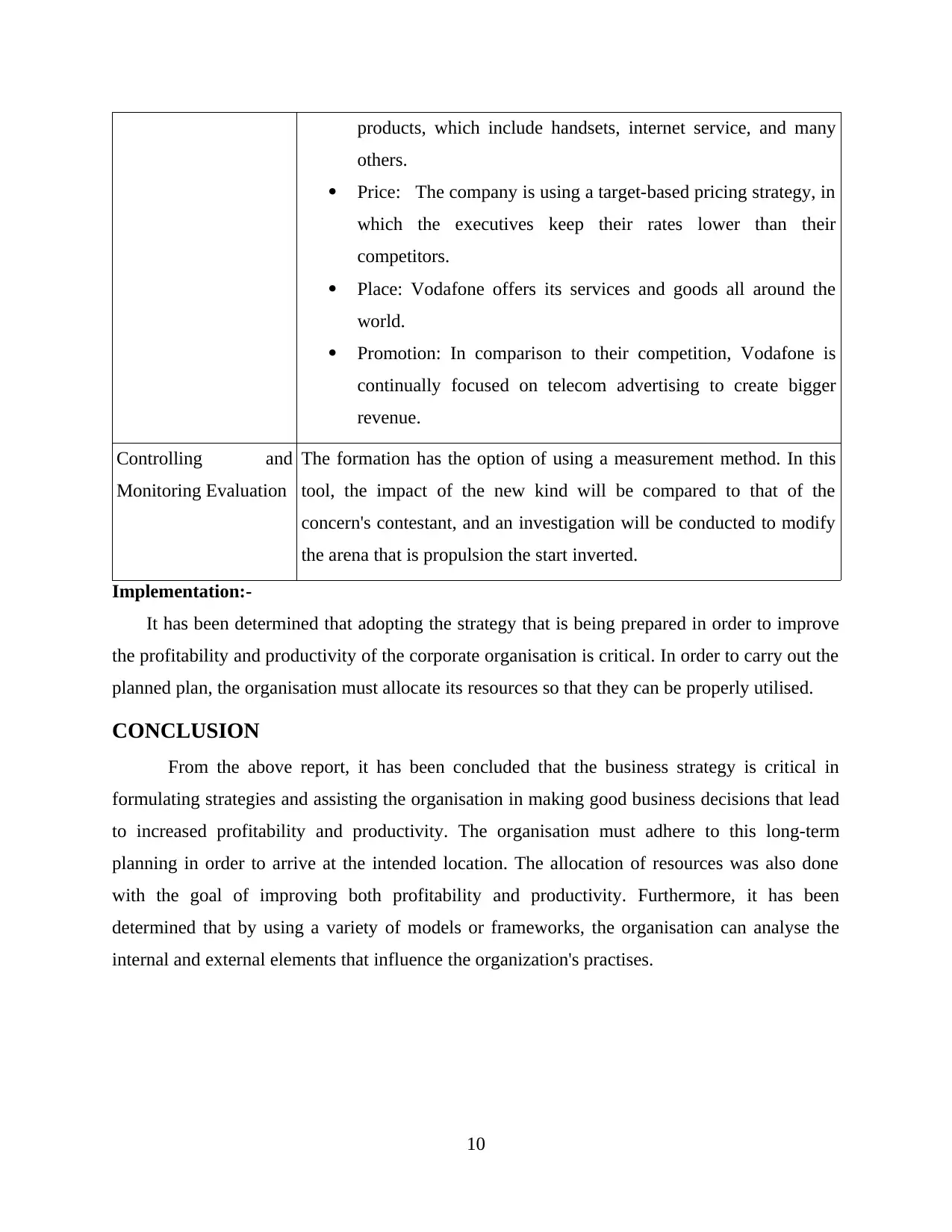
products, which include handsets, internet service, and many
others.
Price: The company is using a target-based pricing strategy, in
which the executives keep their rates lower than their
competitors.
Place: Vodafone offers its services and goods all around the
world.
Promotion: In comparison to their competition, Vodafone is
continually focused on telecom advertising to create bigger
revenue.
Controlling and
Monitoring Evaluation
The formation has the option of using a measurement method. In this
tool, the impact of the new kind will be compared to that of the
concern's contestant, and an investigation will be conducted to modify
the arena that is propulsion the start inverted.
Implementation:-
It has been determined that adopting the strategy that is being prepared in order to improve
the profitability and productivity of the corporate organisation is critical. In order to carry out the
planned plan, the organisation must allocate its resources so that they can be properly utilised.
CONCLUSION
From the above report, it has been concluded that the business strategy is critical in
formulating strategies and assisting the organisation in making good business decisions that lead
to increased profitability and productivity. The organisation must adhere to this long-term
planning in order to arrive at the intended location. The allocation of resources was also done
with the goal of improving both profitability and productivity. Furthermore, it has been
determined that by using a variety of models or frameworks, the organisation can analyse the
internal and external elements that influence the organization's practises.
10
others.
Price: The company is using a target-based pricing strategy, in
which the executives keep their rates lower than their
competitors.
Place: Vodafone offers its services and goods all around the
world.
Promotion: In comparison to their competition, Vodafone is
continually focused on telecom advertising to create bigger
revenue.
Controlling and
Monitoring Evaluation
The formation has the option of using a measurement method. In this
tool, the impact of the new kind will be compared to that of the
concern's contestant, and an investigation will be conducted to modify
the arena that is propulsion the start inverted.
Implementation:-
It has been determined that adopting the strategy that is being prepared in order to improve
the profitability and productivity of the corporate organisation is critical. In order to carry out the
planned plan, the organisation must allocate its resources so that they can be properly utilised.
CONCLUSION
From the above report, it has been concluded that the business strategy is critical in
formulating strategies and assisting the organisation in making good business decisions that lead
to increased profitability and productivity. The organisation must adhere to this long-term
planning in order to arrive at the intended location. The allocation of resources was also done
with the goal of improving both profitability and productivity. Furthermore, it has been
determined that by using a variety of models or frameworks, the organisation can analyse the
internal and external elements that influence the organization's practises.
10
⊘ This is a preview!⊘
Do you want full access?
Subscribe today to unlock all pages.

Trusted by 1+ million students worldwide
1 out of 14
Related Documents
Your All-in-One AI-Powered Toolkit for Academic Success.
+13062052269
info@desklib.com
Available 24*7 on WhatsApp / Email
![[object Object]](/_next/static/media/star-bottom.7253800d.svg)
Unlock your academic potential
Copyright © 2020–2025 A2Z Services. All Rights Reserved. Developed and managed by ZUCOL.





